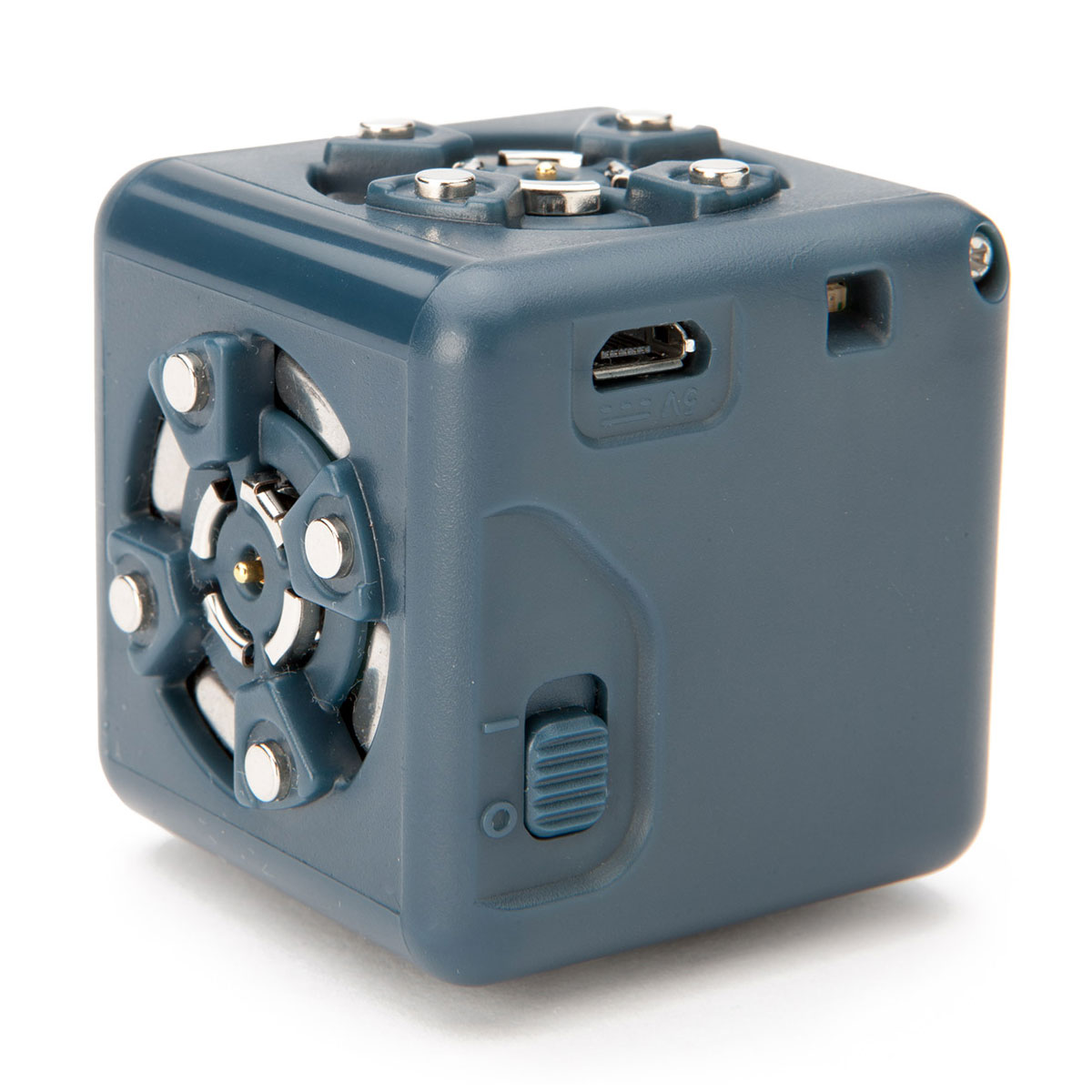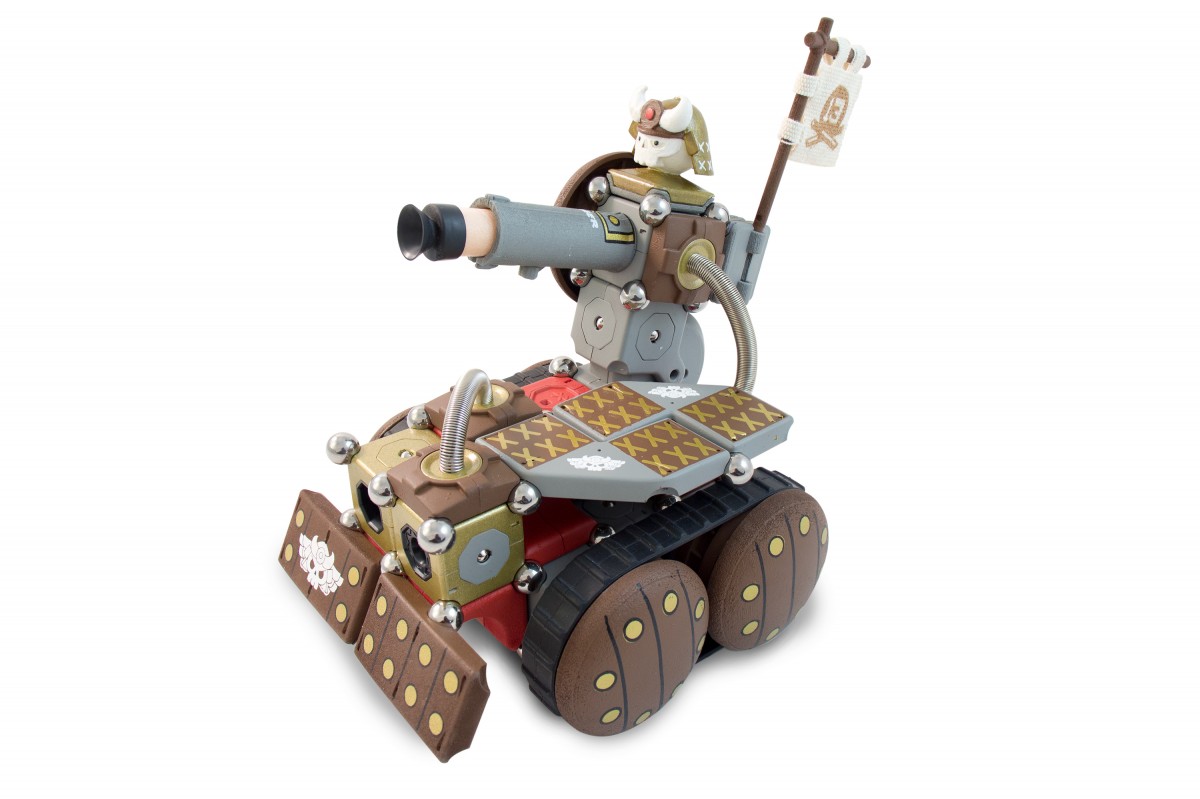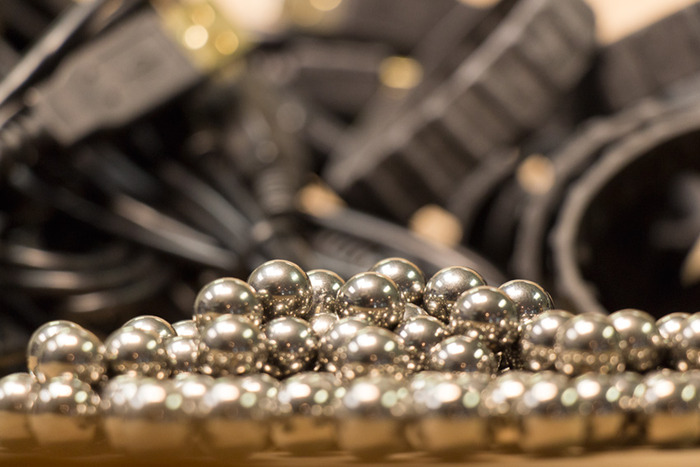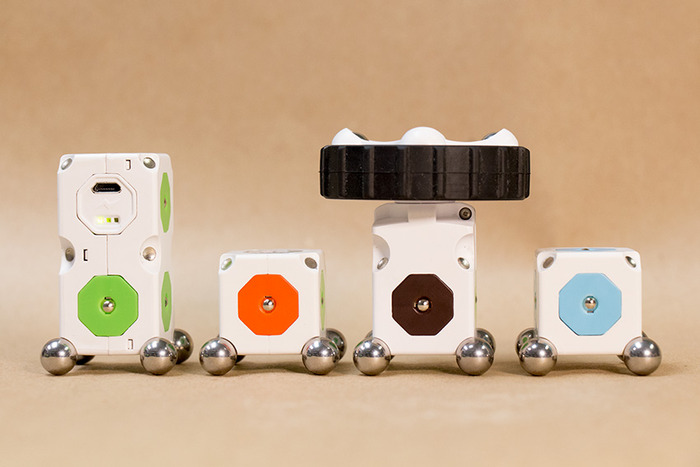All posts by Eric Schweikardt
 The new Battery Cubelet lasts about 30% longer than the old one and it charges more quickly too. Turns out it’s also a lot easier for us to manufacture: we generate fewer scrapped and wasted parts with the new design than with the old.
Back in 2010 when we launched the old Battery Cubelet, most of the little robots made their way to science centers, children’s museums, and schools where they were often in use for all-day sessions. We chose to make the battery cells removable so that these places could buy a bunch of extra cells to keep Cubelets going for a huge day instead of having to buy a bunch of extra Battery Cubelets. It turned out, though, that swapping batteries in and out of Cubelets was just straight annoying and the chargers were clunky to use and slow.
One of the more unique aspects of Cubelets is that it’s a distributed system. When you build a typical robot, you build a plastic and metal body, and then you switch your attention to a laptop and program the brain. With Cubelets, you snap together a bunch of little brain modules that all work together and form a body. If you’re OK with carrying the metaphor a little further, Cubelets most certainly do have a heart: every robot needs a Battery Cubelet to provide power — without it, a construction is dead. That’s why this upgrade is such a big deal.
The new Battery Cubelet is available now on it’s own, as part of the SIX kit, and as part of the big TWENTY kit. Psyched! We didn’t launch many new Cubelets this year, but the new Battery Cubelet is a big one.
The new Battery Cubelet lasts about 30% longer than the old one and it charges more quickly too. Turns out it’s also a lot easier for us to manufacture: we generate fewer scrapped and wasted parts with the new design than with the old.
Back in 2010 when we launched the old Battery Cubelet, most of the little robots made their way to science centers, children’s museums, and schools where they were often in use for all-day sessions. We chose to make the battery cells removable so that these places could buy a bunch of extra cells to keep Cubelets going for a huge day instead of having to buy a bunch of extra Battery Cubelets. It turned out, though, that swapping batteries in and out of Cubelets was just straight annoying and the chargers were clunky to use and slow.
One of the more unique aspects of Cubelets is that it’s a distributed system. When you build a typical robot, you build a plastic and metal body, and then you switch your attention to a laptop and program the brain. With Cubelets, you snap together a bunch of little brain modules that all work together and form a body. If you’re OK with carrying the metaphor a little further, Cubelets most certainly do have a heart: every robot needs a Battery Cubelet to provide power — without it, a construction is dead. That’s why this upgrade is such a big deal.
The new Battery Cubelet is available now on it’s own, as part of the SIX kit, and as part of the big TWENTY kit. Psyched! We didn’t launch many new Cubelets this year, but the new Battery Cubelet is a big one. We’re finishing up the final preparations toward launching our most awesome product ever: the MOSS Huck Tank. I can’t wait until November.
The Huck Tank is the first in the MOSS Artist Series and is designed by Huck Gee. I’ve been in love with Huck’s work ever since seeing the first toys he did with Kidrobot, and I’m super-proud (and still slightly amazed) that he agreed to design a MOSS kit.
The Huck Tank kit has 32 MOSS blocks and is designed to be assembled into a little tank that drives around and shoots things with foam darts. This is a janky hand-painted prototype, but just look at it!

There are two different ways to play with the tank. In autonomous mode, it’ll drive around and avoid obstacles, firing its dart whenever it hears a double clap. Or, download the iOS/Android app and remote control the tank and turret. Of course, you can also build anything you want, or mix and match the Huck Tank modules with your normal MOSS modules to create huge foam dart shooting monster robots.
The white plastic frames that give shape to normal MOSS blocks are injection moulded at one of our suppliers in China. We’ve never been able to injection mould plastic parts in the USA; it’s just always been too expensive. Way too expensive, like we’d need to charge $100 more for a kit expensive. But things have changed: we’re manufacturing the plastic parts that are new in the Huck Tank at an injection moulder in the USA! In Colorado! The supplier is pretty awesome. They’re building the moulds out of aircraft aluminum instead of tool steel, and they should last plenty long. Easier machining in aluminum makes for USA moulds at a competitive (yes, it’s still more expensive, but not double or 10x) price to Chinese manufacturing. Cool.
We offered the Huck Tank as a reward tier on our Kickstarter campaign from six months ago. We’ve shipped out 80% of the MOSS kits from the kickstarter, and the remaining 20% are Huck Tank backers. I’m sorry we’re later than we estimated in the crowdfunding campaign! We expect to ship Huck Tanks in late October 2014, and I’m confident the wait will be worth it.
 We had estimated that we’d be able to ship in February, and we’re finally opening the MOSS pipeline in the last days of March. If our delay screwed with your kid’s birthday or was annoying in another way, please accept my apology: I’m sorry we were late!
Honestly though, I’m blown away by how quickly and efficiently team Modbot moved to get MOSS from prototype to product. MOSS has hundreds of parts in it, most are completely custom, and we’re assembling and testing everything in our own shop in Boulder, CO. The complexity of this effort is astounding and I find myself extremely impressed that we’re shipping only a month or two late. Cubelets took a year longer than planned and every other physical gadget I’ve supported on Kickstarter has shipped with a far longer delay than MOSS.
Last week I ended up in Valdez, Alaska. It just happens to be the 25th anniversary of the oil spill, which I remember vividly watching and reacting to as a twelve year old. That event did a lot to shape the way that I think about the world, but that’s another story. Valdez is the end of the Trans Alaska pipeline, and seeing all of that infrastructure made me think a little bit about the Modular Robotics production pipeline that creates tiny robots and sends them out into the world. Over the last month we’ve been able to assemble some MOSS modules but we’ve been waiting on parts to assemble others. That creates a sort of MOSS reservoir at the beginning of the pipeline. In the last week, as we’ve finally been able to build the few remaining modules in the Zombonitron 1600 kit, we’ve been able to open the valve and start shipping. Right now it feels like we’re running only a trickle of water through our pipeline because we’re triple-testing everything and improving processes as we go. But we’ve designed our pipeline to hold thousands and thousands of tiny robots at a time, so it’ll be fun to watch the volume increase over the next few months.
Kickstarter backers and pre-order friends, we’re amped to send out MOSS to you soon. We don’t have an exact schedule of who gets what when yet, but as our pipeline stabilizes a bit and we have enough data to project, we’ll post better delivery estimates here. For everyone else, we’ll have MOSS available on our web site as soon as we get the pre-orders out the door! In the meantime, here are a few MOSS robots to tide you over.
We had estimated that we’d be able to ship in February, and we’re finally opening the MOSS pipeline in the last days of March. If our delay screwed with your kid’s birthday or was annoying in another way, please accept my apology: I’m sorry we were late!
Honestly though, I’m blown away by how quickly and efficiently team Modbot moved to get MOSS from prototype to product. MOSS has hundreds of parts in it, most are completely custom, and we’re assembling and testing everything in our own shop in Boulder, CO. The complexity of this effort is astounding and I find myself extremely impressed that we’re shipping only a month or two late. Cubelets took a year longer than planned and every other physical gadget I’ve supported on Kickstarter has shipped with a far longer delay than MOSS.
Last week I ended up in Valdez, Alaska. It just happens to be the 25th anniversary of the oil spill, which I remember vividly watching and reacting to as a twelve year old. That event did a lot to shape the way that I think about the world, but that’s another story. Valdez is the end of the Trans Alaska pipeline, and seeing all of that infrastructure made me think a little bit about the Modular Robotics production pipeline that creates tiny robots and sends them out into the world. Over the last month we’ve been able to assemble some MOSS modules but we’ve been waiting on parts to assemble others. That creates a sort of MOSS reservoir at the beginning of the pipeline. In the last week, as we’ve finally been able to build the few remaining modules in the Zombonitron 1600 kit, we’ve been able to open the valve and start shipping. Right now it feels like we’re running only a trickle of water through our pipeline because we’re triple-testing everything and improving processes as we go. But we’ve designed our pipeline to hold thousands and thousands of tiny robots at a time, so it’ll be fun to watch the volume increase over the next few months.
Kickstarter backers and pre-order friends, we’re amped to send out MOSS to you soon. We don’t have an exact schedule of who gets what when yet, but as our pipeline stabilizes a bit and we have enough data to project, we’ll post better delivery estimates here. For everyone else, we’ll have MOSS available on our web site as soon as we get the pre-orders out the door! In the meantime, here are a few MOSS robots to tide you over.
 Colors are locked, and they’re gorgeous. The photo below is a little wonky and still doesn’t show the colors accurately, but we just shot beautiful new pro photos and I’ll post them asap. We vacillated a lot with color selection, made a last-hour decision to switch to a two-color face scheme, and then reversed that in a last-minute decision to in favor of the original four-color face scheme:
Colors are locked, and they’re gorgeous. The photo below is a little wonky and still doesn’t show the colors accurately, but we just shot beautiful new pro photos and I’ll post them asap. We vacillated a lot with color selection, made a last-hour decision to switch to a two-color face scheme, and then reversed that in a last-minute decision to in favor of the original four-color face scheme:
- Green = Power
- Red = Data Output
- Brown = Data Input
- Blue = Pass-through
 We’re still on track to get the first MOSS kits out the door in February!
We’re still on track to get the first MOSS kits out the door in February! 

